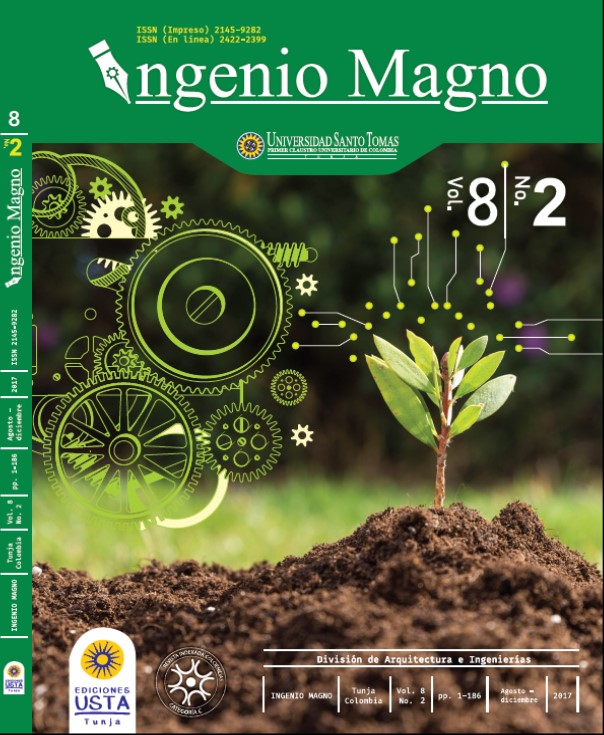Design of a monitoring system for the acquisition of noninvasive electromyographic signals in upper extremities
Main Article Content
Abstract
Downloads
Article Details
DECLARATION OF ORGINIALITY OF SUBMITTED ARTICLE
With this document, I/We certify that the article submitted for possible publication in the institutional journal INGENIO MAGNO of the Research Center Alberto Magno CIIAM of the University Santo Tomás, Tunja campus, is entirely of my(our) own writing, and is a product of my(our) direct intellectual contribution to knowledge.
All data and references to completed publications are duly identified with their respective bibliographical entries and in the citations thus highlighted. If any adjustment or correction is needed, I(we) will contact the journal authorities in advance.
Due to that stated above, I(we) declare that the entirety of the submitted material is in accordance with applicable laws regarding intellectual and industrial property, and therefore, I(we) hold myself(ourselves) responsible for any complaint related to it.
If the submitted article is published, I(we) declare that I(we) fully relinquish publishing rights of the article to the University Santo Tomás, Tunja campus. As remuneration for this relinquishment of rights, I(we) declare my(our) agreement to receive two (2) copies of the edition of the journal in which my(our) article appears.
References
Reaz, M., & Hussain, F., (2006). Techniques of EMG Signal Analysis: Detection, Processing, Classification and Applications. Biological Procedures.
Adel, R., & Luykxr. (1991). Electroterapia de frecuencia baja y media. Netherland: Editorial Alfa.
Akhtar, A., Aghasadeghi, N., Hargrove, L., & Bretl, T. (2017). Estimation of distal arm joint angles from EMG and shoulder orientation for transhumeral prostheses. Journal of Elec-tromyography and Kinesiology, 35, 86–94. https://doi.org/10.1016/j.jelekin.2017.06.001
Boschetti., G. (2002). ¿Que es la electroestimulación? Teoría, práctica y metodología del entrenamiento., Barcelona: Editoria Paidotribo.
Clancy, E. A., Martinez-luna, C., Wartenberg, M., Dai, C., & Farrell, T. R. (2017). Two de-grees of freedom quasi-static EMG-force at the wrist using a minimum number of electrodes q. Journal of Electromyography and Kinesiology, 34, 24–36. https://doi.org/10.1016/j. jelekin.2017.03.004
Hoz, E. D. La, Franklin, J., Marques, D. A., & Gallego, O. (2015). Utilidad del Biofeedback Perineal en las disfunciones del piso pélvico.
Khushaba, R. N., Al-timemy, A., Kodagoda, S., & Nazarpour, K. (2016). Combined influence of forearm orientation and muscular contraction on EMG pattern recognition. Expert Systems With Applications, 61, 154–161. https://doi.org/10.1016/j.eswa.2016.05.031
Kim, B., Kim, L., Kim, Y., & Yoo, S. K. (2017). ScienceDirect Cross-association analysis of EEG and EMG signals according to movement intention state. Cognitive Systems Re-search, 44, 1–9. https://doi.org/10.1016/j. cogsys.2017.02.001
Malanda, A., Rodriguez-falces, J., Porta, S., & Navallas, J. (2017).
Biomedical Signal Processing and Control Motor unit profile: A new way to describe the scanning-EMG po-tential, 34, 64–73. https://doi.org/10.1016/j.bspc.2016.12.020
Moreno, O., González, J. & Ballesteros, J. (2015). Transformación de archivos DICOM a formatos XML, JPEG y PNG. Revista Científica, 21, 71-80. Doi: 10.14483/udistrital.jour. RC.2015. 21.a7
Verikas, A., Parker, J., Bacauskiene, M., & Olsson, M. C. (2017). Exploring relations be-tween EMG and biomechanical data recorded during a golf swing, 88, 109–117. https://doi.org/10.1016/j.eswa.2017.06.041
Villamizar, J., & Sc, P. M. (2012). Brazo robótico controlado por electromiografía.
Laplante, Phillip A. (2005). Comprehensive dictionary of electrical engineering. Boca Raton, FL: Taylor & Francis.
Reaz, M., & Hussain, F., (2006). Techniques of EMG Signal Analysis: Detection, Processing, Classification and Applications. Biological Procedures.

